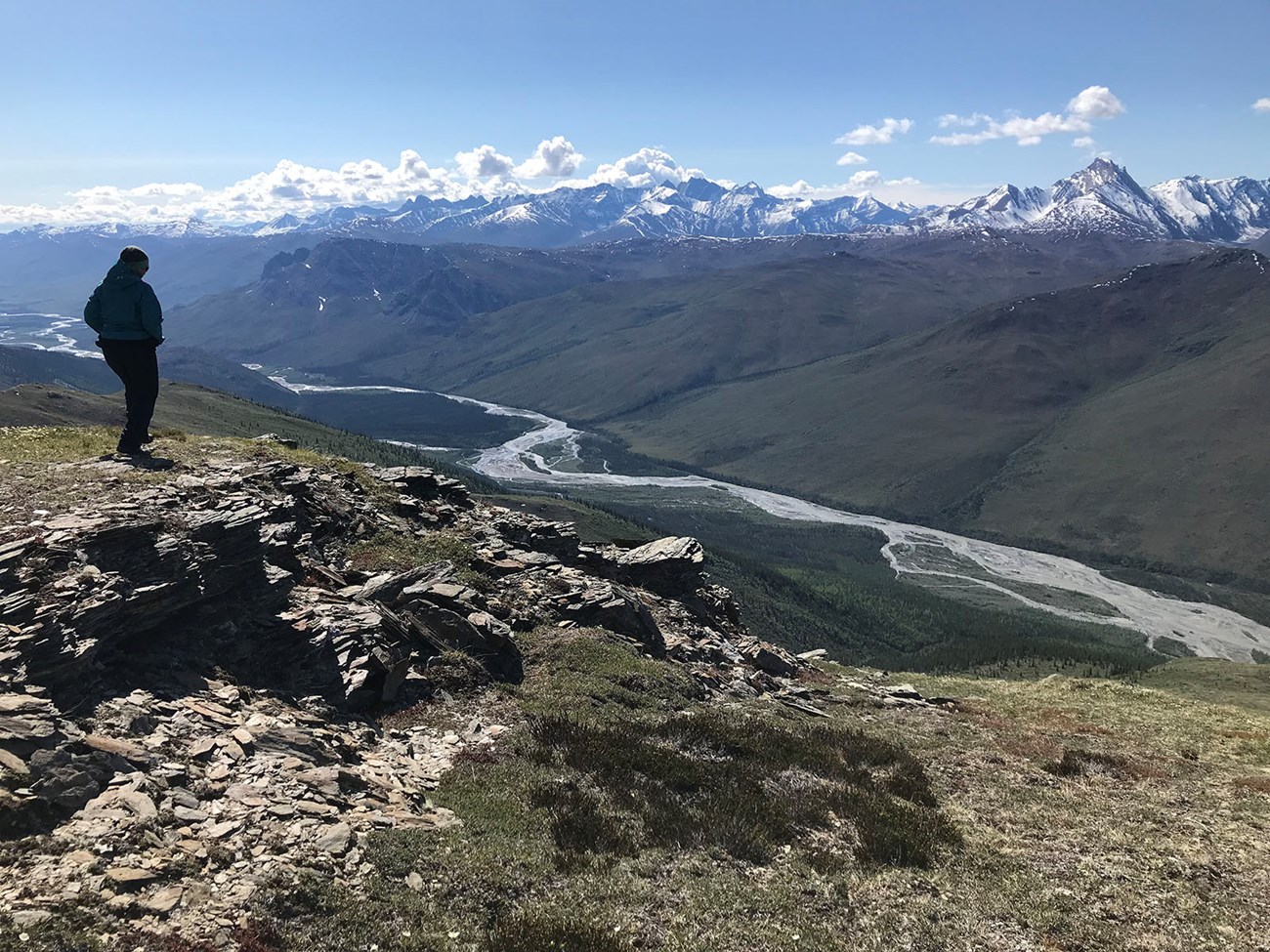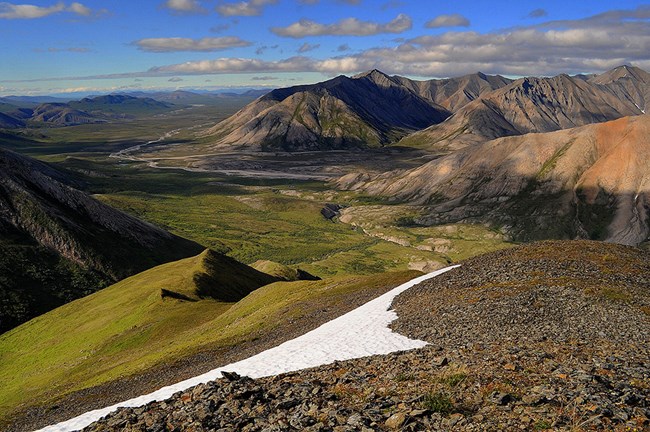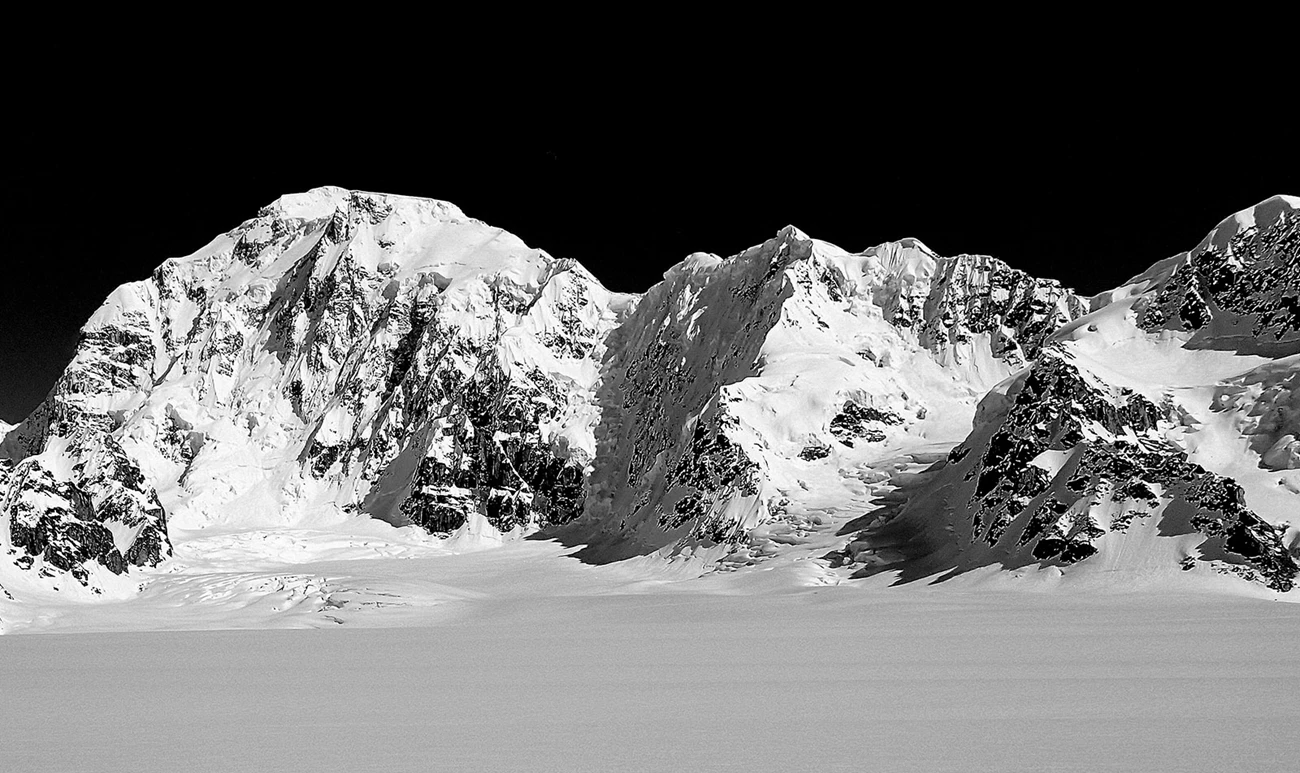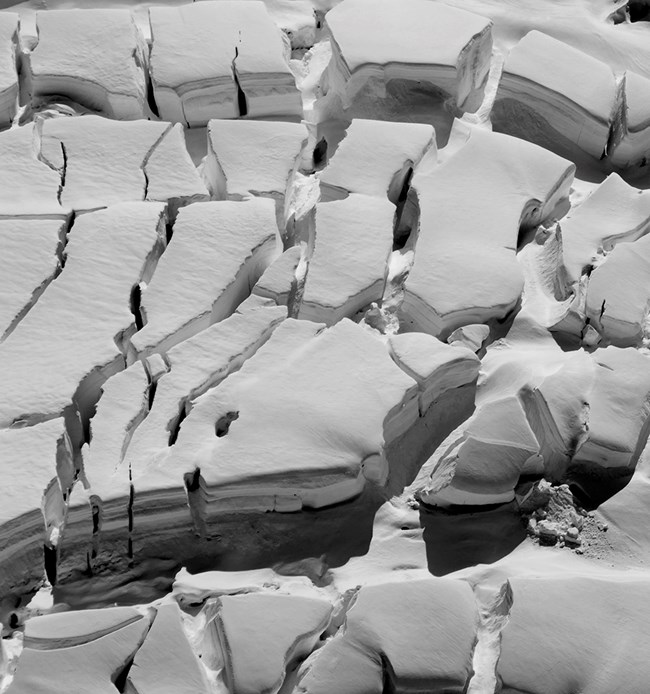Part of a series of articles titled Reckoning with a Warming Climate.
Article
High-Latitude National Parks on the Cusp of Change
Maggie MacCluskie, Program Manager, Central Alaska Network, National Park Service
Pamela J. Sousanes, Physical Scientist, Central Alaska Network and Arctic Network, National Park Service
The wild lands of Alaska national parks are changing at a rapid pace due to the disproportionate increases in temperature at high latitudes. The uncertainty about cumulative climate changes and how they will impact specific regions is one of the greatest challenges facing park managers. Climate has fundamentally shaped the landscape of high-latitude parks, but now climate change is redefining them.Download a pdf of the full issue

NPS/KEN HILL
The wild lands of Alaska national parks are changing at a rapid pace due to the disproportionate increases in temperature at high latitudes (Gonzalez et al. 2018). Uncertainty about cumulative climate changes and how they will impact specific regions is one of the greatest challenges facing park managers who are charged with preserving these parks unimpaired for future generations.
Climate has fundamentally shaped the landscape of these high-latitude parks, but now climate change is redefining them. Nothing is static in nature. These parks are continually changing, but what has become so prominent and disconcerting, is the rapid and accelerating rate of change. There is less sea ice, snow seasons are shorter, and temperatures both above and below ground are warmer (IPCC 2021, Markon et al. 2018). The ripple effects of these changes manifest in different ways across park landscapes and scientists and local communities are continuously gathering information and data to aid in climate adaptation planning efforts. Future changes will impact how land stewards will manage natural and cultural resources, food availability, and the fundamental aspects of living on land that is thawing beneath our feet.
High-latitude environments dominated by snow and ice are particularly vulnerable to increases in temperature. Several parks in Alaska have average annual temperatures that hover near 0°C and even small increases in temperatures could mean the difference between rain or snow, permafrost or thawed ground, glaciers or no glaciers. Crossing the 0°C threshold, the difference between liquid water rather than snow or ice, influences the health and abundance of plants and animals that live in the parks and the hydrologic systems that support them.
The flora and fauna of the parks are contending with increases in temperature, shorter snow/ice seasons, longer thaw seasons, and increased disturbance in the form of fire and pests. These changes also impact the communities that call these places home. Parks have boundaries on maps, but nature transcends them. People, who have lived in and around these parks for thousands of years, depend on the caribou, moose, and fish that move across these lands. These people have deep connections to the land and their observations and experiences are critical to understanding local impacts. People who steward these lands and resources are monitoring changes to document and quantify the impacts of climate change. Park managers have prioritized science and climate change action as a top priority for the Alaska parks and use the data, the science, and the results to make informed decisions. The results of park-based science are transferred to park visitors, local community residents, school kids, and the public generally by the front-line park staff who make the critical connection. The science is gathered locally but applicable globally.
Alaska Climate Beyond Parks
The climate in Alaska varies tremendously, from the maritime parks along the Gulf of Alaska to the continental interior parks, to the Arctic parks along the Chukchi Sea. It is as complex and diverse as the climates of all 48 contiguous states combined (Shulski and Wendler 2007). Multiple mountain ranges, local topographic features, and proximity to the ocean are all factors that influence local temperature and precipitation patterns (Bieniek et al. 2012). Arctic sea ice extent and duration in the north, along with the North Pacific sea surface temperatures to the south, significantly influence the terrestrial air temperatures and weather extremes on adjacent land. There is less sea ice today than there was 30 years ago (NSIDC 2022). Arctic sea ice that lasts through the summer has decreased by 13% per decade since measurements began in 1979 (NOAA 2022a, NSIDC 2022). Ocean temperatures in the north Pacific have increased (NOAA 2022a). This combination leads to warmer air temperatures and increased moisture availability due to the longer ice-free seasons (Gonzalez et al. 2018, Swanson et al. 2021). The darker land and ocean surfaces, now free of ice and snow for longer periods, absorb more of the sun’s energy, and amplify the original warming. Alaska temperatures are warming at least twice as fast as the global average and the global climate models project an even warmer future (Markon et al. 2018).
However, atmospheric and oceanic circulation patterns are not static. Extreme weather events, including floods, droughts, heat waves, and cold snaps occur when persistent weather patterns take hold and are slow to move or change. While the overall direction of change is toward warmer and wetter conditions, this does not preclude the possibility of drought in a temperate rain forest (Walston et al. 2023) or consecutive La Niña events that bring colder temperatures to Alaska (2020-2023; NOAA 2022b). Observed changes in temperature and precipitation have been non-monotonic over the last century, linked to atmospheric and oceanic circulation patterns that occur over annual, decadal, and multi-decadal time frames (Markon et al. 2018, Bieniek et al. 2014).

Imelyak, Noatak National Preserve.
NPS/KEN HILL
Preservation in Times of Change
Park scientists, research scientists, and local communities are all striving to understand how climate change is playing out across the northern landscape. Future changes will impact how land stewards will manage natural and cultural resources, food availability, and the daunting challenge of living on a thawing landscape. This issue of Alaska Park Science will use several themes to present a review of the science and knowledge related to the rapidly changing landscape.
- Crossing the zero-degree threshold: A summary of key findings that focus on how even a small increase in temperature has a profound impact in Alaska parks that are defined by snow and ice.
- What happens when northern oceans get too warm: A collection of studies that couple long-term monitoring data with focused research studies to assess changes over time in marine ecosystems in and adjacent to national parks in Alaska.
- How wildlife are responding to a warming climate: A synthesis of the complex interactions between climate change, habitat, and wildlife across elevational and latitudinal ranges with observations from research and monitoring studies conducted in Alaska parks.
- Alaska’s changing vegetation processes and patterns: Plant responses to unprecedented levels of warming in the Far North: A reflective perspective from a park botanist on the observed changes in both the functional and structural changes in landscape level vegetation across park lands, based on decades of monitoring.
- Using satellite imagery to detect the changing seasonality of river ice: River corridors provide access for the traditional harvest of local wild food resources. This research, using remote sensing mapping techniques, suggests that warmer temperatures from October through April are reducing the season of river ice travel on the Copper River in and adjacent to Wrangell-St. Elias National Park and Preserve.
- Traditional knowledge of changes in winter conditions in Alaska’s Copper River Basin: In Alaska’s Copper River Basin, less reliable snow and ice have presented challenges for traditional wintertime activities such as trapping, hunting, and gathering firewood. Elders shared their extensive knowledge and experience of change on the Copper River through a series of interviews compiled in this article.
- Stories yet told: Alaska’s cultural heritage in a time of unprecedented climate change: A narrative describing some projects and initiatives underway – across parks in Alaska and in partnership with Alaskan communities – that respond to the impact of climate change on heritage sites and cultural resources.
- Responding to the effects of climate change on subsistence in Alaska: This article describes the challenges climate change poses to subsistence harvests, ways subsistence users are adapting to change, and how the National Park Service can support continued subsistence opportunities in Alaska.
- Communicating science and inspiring hope: Relaying the science of climate change to the public is not only about the transfer of information, but also about inspiring the audience to appreciate and care about what the facts represent. The authors lay out a framework of effective communication that can provoke and encourage people to take action.
- Planning for future climates at Wrangell-St. Elias: Mainstreaming park-based actions: Deciding how to act in the face of climate change can be overwhelming. Yet there are actions any park can take to integrate climate change considerations into their operations. This article describes how park managers can understand, adapt to, mitigate the causes of, and communicate with the public about climate change.
Our work to understand and manage the effects of a changing climate on natural and cultural resources, infrastructure, and operations are core responsibilities of the National Park Service and rooted in our mission to protect parks and support visitor experience and enjoyment for present and future generations (NPS 2019). This collection of articles provides a glimpse of the science and communication related to climate change in the high-latitude national parks where temperatures are warming fast. It is not comprehensive, nor static, and we learn more each day. We encourage you to explore further.
References
Bieniek, P. A., U. S. Bhatt, R. L. Thoman, H. Angeloff, J. Partain, J. Papineau, F. Fritsch, E. Holloway, J. E. Walsh, C. Daly, M. Shulski, G. Hufford, D. F. Hill, S. Calos, and R. Gens. 2012.
Climate Divisions for Alaska Based on Objective Methods. Journal of Applied Meteorology and Climatology 51(7): 1276-1289.
Bieniek, P. A. J. E. Walsh, R. L. Thoman, and U. S. Bhatt. 2014.
Using climate divisions to analyze variations and trends in Alaska temperature and precipitation. Journal of Climate 27(8): 2800-2818.
Gonzalez, P., F. Wang, M. Notaro, D. J. Vimont, and J. W. Williams. 2018.
Disproportionate magnitude of climate change in United States national parks. Environmental Research Letters 13(10): 104001.
Intergovernmental Panel on Climate Change (IPCC). 2021.
Climate Change 2021: The Physical Science Basis. Contribution of Working Group I to the Sixth Assessment Report of the Intergovernmental Panel on Climate Change [Masson-Delmotte, V., P. Zhai, A. Pirani, S.L. Connors, C. Péan, S. Berger, N. Caud, Y. Chen, L. Goldfarb, M.I. Gomis, M. Huang, K. Leitzell, E. Lonnoy, J.B.R. Matthews, T.K. Maycock, T. Waterfield, O. Yelekçi, R. Yu, and B. Zhou (eds.)]. Cambridge University Press, Cambridge, United Kingdom and New York, NY, USA.
Markon, C., S. Gray, M. Berman, L. Eerkes-Medrano, T. Hennessy, H. Huntington, J. Littell, M. McCammon, R. Thoman, and S. Trainor. 2018.
Alaska. pp. 1185-1241 In Impacts, Risks, and Adaptation in the United States: Fourth National Climate Assessment, Volume II [Reidmiller, D. R., C. W. Avery, D. R. Easterling, K. E. Kunkel, K. L. M. Lewis, T. K. Maycock, and B. C. Stewart (eds.)]. U.S. Global Change Research Program, Washington, DC.
National Oceanic and Atmospheric Administration (NOAA). 2022a.
National Oceanic and Atmospheric Administration, Global Climate Dashboard. Tracking climate change and variability over time. Available at: https://www.climate.gov/climatedashboard. (accessed October 13, 2022)
National Oceanic and Atmospheric Administration (NOAA). 2022b.
National Oceanic and Atmospheric Administration (NOAA) Physical Sciences Laboratory La Nina Index Dashboard. Available at https://psl.noaa.gov/enso/dashboard.lanina.html (accessed December 5, 2022).
National Park Service (NPS). 2019.
National Park Service Climate Change Response Program Strategic Plan. Available at https://home.nps.gov/orgs/ccrp/upload/CCRP-Strategic-plan-508-smaller.pdf (accessed on July 7, 2023).
National Snow and Ice Data Center (NSIDC). 2022.
Arctic Sea Ice News and Analysis. Available at https://nsidc.org/home (accessed October 13, 2022).
Shulski, M. and G. Wendler. 2007.
The Climate of Alaska. University of Alaska Press. Fairbanks, Alaska.
Swanson, D. K., P. J. Sousanes, and K. Hill. 2021.
Increased mean annual temperatures in 2014–2019 indicate permafrost thaw in Alaskan national parks. Arctic, Antarctic, and Alpine Research 53(1): 1-19.
Walston, J. M., S. A. McAfee, and D. J. McEvoy. 2023.
Evaluating drought indices for Alaska. Earth Interact. 27: e220025.

NPS/KEN HILL

NPS/KEN HILL
Alaska Park Science
Volume 22, Issue 1September 2023
Editorial Board:
Grant Hilderbrand
Jim Lawler
Eva Patton
Jeff Rasic
Jennifer Pederson Weinberger
Guest Editors:
Maggie MacCluskie
Pamela J. Sousanes
Managing Editor: Nina Chambers
Copy Editor: H. W. Murphy
Design: Nina Chambers
Alaska Park Science is the semi-annual science journal of the National Park Service Alaska Region. Each issue highlights research and scholarship important to the stewardship of Alaska’s parks. Publication in Alaska Park Science does not signify that the contents reflect the views or policies of the National Park Service, nor does mention of trade names or commercial products constitute National Park Service endorsement or recommendation.
Last updated: September 8, 2023
